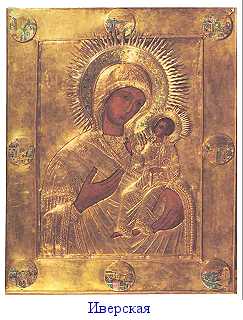Iberian icon of Mother of God
This icon has been revered since the mid-9th century. Its first copy was brought to Russia from Greece in 1648 by order of Patriarch Nikon. The copy, made by Monk [amvlikh Romanov, was painted on a cypress panel with pigments that were mixed with particles of holy relics. It was kept in the domestic chapel of Tsarevna Sofia (Susanna), the sister of Tsar Peter the Great. Particularly highly revered was its copy, made at an unknown date, which was installed in the Chapel of the Iberian Icon of the Mother of God (built in 1659-1660 to collect donations for the Monastery of St. Nicholas in Pererva) next to the Gates of the Protecting Veil of the Kitai-Gorod wall in Moscow. The icon was adorned with coins, small pectoral icons, medals, crosses, rings, portraits, and repesentations of afflicted parts of the body. After the 1917 revolution the chapel was destroyed and nothing is known about what has become of this copy. The two copies of the Greek icon were used as models for Molchanovo, New Jerusalem, Nizhni Novgorod, Tambov, Sukhotinka, Saratov, and Kishinev copies of the holy image. Today the first copy of the icon is believed to be kept in the Church of the Resurrection in Sokolniki (Moscow). Feast days February 12/25, October 13/26 and Bright Tuesday.

